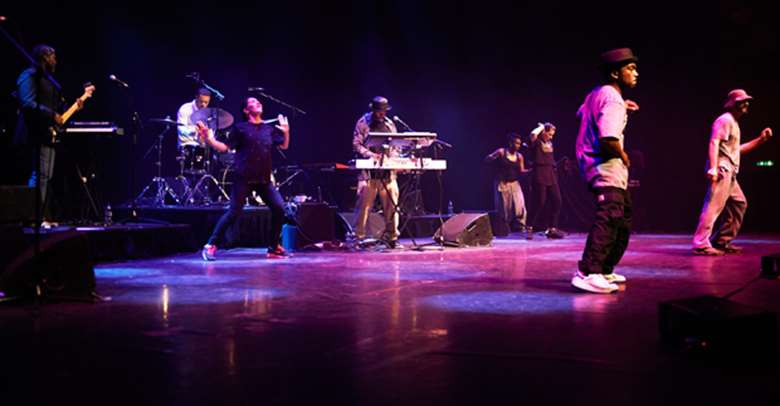Theo Parrish dancing to his own beat at Barbican
Tuesday, July 15, 2014
House is synonymous with dance.

The natural successor to disco and the co-conspirator of techno, the genre is intended to obey a time-honoured impulse in African-American culture – ‘you gotta get up to get down’ – instead of observing the more detached stance of the ‘head nod’, or indeed ‘the profile’ that is largely prevalent in hip-hop.
Interviewed by Josey Rebelle for Time Out prior to this gig, Theo Parrish, a Detroit artist whose Sound Signature catalogue has made him a seminal name in house, made this important point. “People don't know how to dance anymore.” If that was a blunt denunciation of a certain self-consciousness if not confected uber-cool that effectively restricts people from really feeling house music then Parrish addressed the malaise within moments of leading a stellar ensemble – Amp Fiddler [keys], Duminie De Porres [guitar], Akwasi Mensah [bass], Myele Manzanza [drums] – on stage for this sold-out performance. He told assembled fans that his ultimate goal was unity. To that end they had to see their seats as springboards rather than cushions.
A few songs later the crowd duly complied, but it was more than just the beauty of the music that prompted the response to Parrish’s call. His master stroke was to include in his ensemble four brilliant dancers who essentially acted as additional band members, capturing the kinesis of the beat and throwing it back to the audience by way of choreography that blended a sharp pop ‘n’ lock thrust with the looser, more fluid upswing of jazz dance. Just a week before this gig bassist Mensah had performed The Dynamics Of Perception, a brilliant live soundtrack at the Purcell room that also built a bridge between music and dance on film, and this gig seemed to be an uncanny and logical extension of that premise. It was fascinating to see how much the dancers completely led the audience, raising its energy levels time and again with a virtuosic step just as the climax of a piano improvisation can draw a sharp intake of breath from any truly attentive listener.
Dancer as soloist may have implied jazz, but Parish’s arrangements and musical sensibilities made an entirely explicit application thereof. Any number of songs, particularly ‘Top Of The World’, ‘Chemistry’ and ‘Solitary Flight’, had the kind of harmonic framework of the hallowed 1970s fusion lexicon a la Herbie-Lonnie-Ubiquity, perhaps more pared down to up the rhythmic charge, all the while leaving ample pace for the likes of Fiddler, De Porres and Manzanza to fully extemporize. Particularly impressive was the way that the latter wove fine patchworks of syncopation around the primal 4/4 kick drum pulse, displaying a lightness of touch on the sticks and tympani mallets that brought additional layers to the percussive base of the music. Parrish himself played slinky keys and a sexily squelched-out moog bass, making the point that many progressive producers – think 4-Hero, I.G Culture, Stacey Pullen to name a few – are musicians as well as soundscapers, and that their formative references place Quincy Jones alongside Larry Heard.
To a great extent, the major clue to the grand cultural sweep of Parrish’s world was the understated quote of Stevie Wonder’s ‘Too High’ that acted as a bed for his opening address to the audience. When one thinks of Wonder’s history – his development of Ray Charles’ soul; his immersion in the worlds of Ellington, Gershwin, the Beatles and John Coltrane; his creation of an advanced electronica and proto-Techno in the ‘70s that is still enormously relevant today – it is clear that the piece could not have been a mo’ better scene-setter.
Then again the appearance of Parrish’s two vocalists, Ideeyah and Chalin Barton, sealed the Stevie deal insofar as they brought to the table the gospel energy at the epicenter of Parrish’s musical universe, underling the presence of the black church and the essence of congregation that underscore his appearances both as a club DJ and a concert hall bandleader.
If country preachers played no small part in the Civil Rights struggle then guitarist De Porres kept that political gospel connection alive when he recited a list of fallen freedom fighters, from Nat Turner to Fred Hampton, before launching into his most searing wah wah eruption of the night. That said, those with an open mind would have also seen that there was an immense historical dimension to this event. By bringing together jazz musicians, dancers, singers and great songs, Parrish was actually presenting an imaginative update of the heritage of Detroit: a Motown Revue for the millennium. The icing on the cake was the appearance of a British horn section, trumpeter Jay Phelps and tenor saxophonist Ray Carless. Their sweet, soaring brass had an unseated audience walking through the sky. Landmark gig from a monumental artist.
– Kevin Le Gendre
– Photo by Egle Trezzi